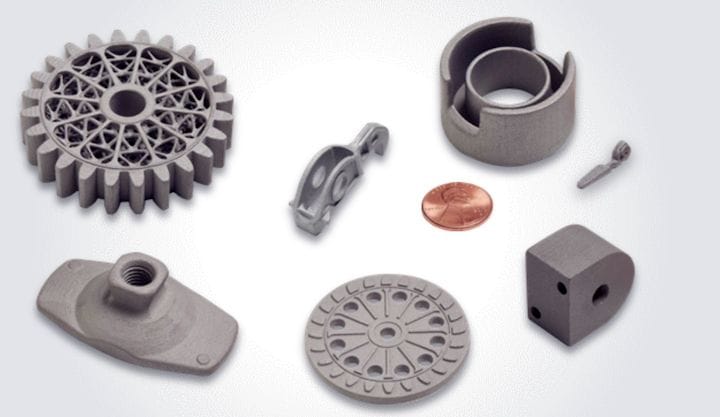![Printed metal parts from HP's new Metal Jet technology [Source: HP]](https://fabbaloo.com/wp-content/uploads/2020/05/image-asset_img_5eb0a7afbf4c1.jpg)
HP announced a new metal 3D printing process today, and there are some interesting implications.
Their process once again leverages that company’s powerful inkjet nozzle technology. I’m beginning to wonder if HP is actually a nozzle company, as so many of their most powerful products rely on that particular component.
Nevertheless, HP’s new Metal Jet technology is an adaptation of their previous foray into plastic 3D printing. The Metal Jet process selectively inks binder to layers of MIM powder to gradually form a “green” object. The green part is then sintered in a furnace to remove the binder and fuse the metal particles together.
HP has built the technology into a larger batch-style package designed to address the needs of manufacturers. The idea is that the large 430 x 320 x 200 mm build chamber will be able to 3D print larger quantities of objects in single job runs.
Because the technology is powder-based, the prints require no support structures: they are supported by the surrounding powder during printing. This means that you could stack in many objects into a single print job. For example, a 50 x 50 x 50 mm object could be produced in at least 220 units per job. More are possible if the geometry is such that you can overlap the bounding box somewhat.
Thus this machine is designed for throughput: many parts will emerge from each job run. It’s therefore a manufacturing machine, not a prototyping machine.
And that is HP’s strategy: their intention is to jump into the production space, which is where the majority of the spending occurs. Prototyping is a very tiny fraction of the investment used for making objects. HP says this market is up to US$12T worldwide, creating a staggeringly large potential for their equipment.
Will they succeed? I think they have a couple of significant challenges ahead of them.
Conservativity: Like it or not, many manufacturing organizations are risk averse and would prefer to not change things much. This is a problem that HP must address in some way, but some organizations may require generational change to overcome it.
Size: While HP’s Metal Jet technology offers a substantial build volume, its relatively small size will automatically deny use by anyone making larger parts. This will shrink their potential market. However, HP says that the technology is potentially scalable, so it is possible they may offer increasingly larger versions over time.
Creativity: The optimal use of 3D printing technology is to design parts that were not possible to make with traditional approaches. Manufacturers must become far more creative in order to do so. They will require different software, processes and especially thinking and such changes will certainly be extremely challenging in many businesses. It’s not that easy to create complex designs such as the sparse gear wheel at top left. Watch for HP to eventually set up some mechanism to resolve this issue.
Cost: While HP’s estimated per-part price is far lower than earlier 3D metal printing systems, it is still higher than some other traditional approaches. Thus for many parts the HP system will be financially infeasible. HP will have to lower Metal Jet’s total cost of part production even more in the future to grow to the largest possible market. However, this is the moment of the product’s introduction, so the costs are likely highest. They could begin to reduce prices as manufacturers adopt the technology and economies of scale increase.
Competitors: For the moment the alternative, more expensive 3D metal printer companies should not be too concerned, as their markets are relatively secure: some will have obtained critical industry certifications for their use of the equipment after years of effort. This would have to be repeated if they change their equipment to the new HP platforms. As well, HP is only offering stainless steel material, so if you need, say, titanium 3D prints, you are going elsewhere. However, over time both of these barriers will slowly dissipate and the older metal 3D printer companies could become concerned.











The debate over use of proprietary or open materials ecosystems is becoming a big topic in 3D printing.